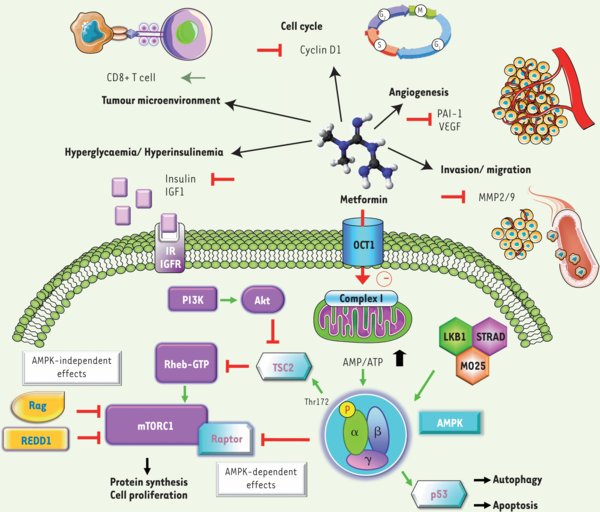Figure 3.

Télécharger l'image originale
Principal mechanisms of action described for metformin’ inhibition of tumour growth. Several different modes of action have been suggested, due to the diversity of in vivo and in vitro cancer models studied. At system level, metformin reduces blood insulin and IGF1 levels, which blocks stimulation of the PI3K/AKT/mTORC1 signalling pathways and cell proliferation. At cell level, metformin inhibits the mTORC1 (mammalian target of rapamycin complex 1) pathway via mechanisms dependent on AMPK activation by phosphorylation of TSC2 (tuberous sclerosis complex 2) and raptor (regulatory associated protein of mTOR). However, metformin is able to inhibit the mTORC1 pathway via AMPK-independent mechanisms, by inhibiting Rag GTPases and inducing REDD1 expression. It is possible that the drug acts at the level of cell cycle regulation by inhibiting cyclin D1 expression. At the tumour microenvironment level, stimulation of memory T cell generation also contributes to plays a part in metformin’s beneficial effects. Metformin causes a reduction in neoplastic cell angiogenesis by lowering blood concentrations of PAI-1 (plasminogen activator inhibitor-1) and VEGF (vascular endothelial growth factor). Inhibition of metastasis formation through decreased activity of the metalloproteinases MMP2 and -9 has also been described.
Les statistiques affichées correspondent au cumul d'une part des vues des résumés de l'article et d'autre part des vues et téléchargements de l'article plein-texte (PDF, Full-HTML, ePub... selon les formats disponibles) sur la platefome Vision4Press.
Les statistiques sont disponibles avec un délai de 48 à 96 heures et sont mises à jour quotidiennement en semaine.
Le chargement des statistiques peut être long.




